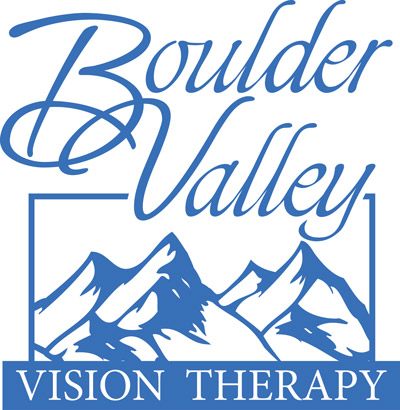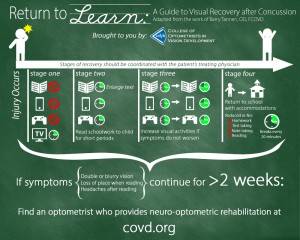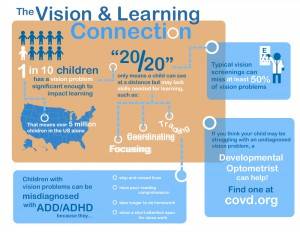
1. Where do I find the visual symptom checklist? You can call or e-mail Dr. Simonson to forward you a copy by mail or e-mail, or download a pdf version here: http://vision-learning.org/spotprobs.html
2. Can Dyslexia actually be a vision problem?
Dyslexia is a neurological dysfunction marked by the inability of the brain's language centers to efficiently decode print or phonetically make the connection between written symbols and their appropriate sounds. Not all children who struggle to read, however, suffer from phonological processing problems. Although the symptoms are similar, the culprit for many may be vision, not a language-based deficit.
Margaret Livingstone, et al, from the Department of Neurobiology, Harvard Medical School and the Dyslexia Research Laboratory, Beth Israel Hospital in Boston reports that poor visual processing plays a significant role in a large majority of children who struggle to read: "Several perceptual studies have suggested that dyslexic subjects process visual information more slowly than normal subjects. Such visual abnormalities were reported to be found in more than 75% of the reading-disabled children tested."
A complete eye exam by a developmental optometrist trained to diagnose and treat vision-based learning problems can determine for certain if vision is the basis of a child's struggle to read. For more complete information on this topic, see our "Vision and Reading" page.
Below is the position statement of the American Academy of Optometry and the American Optometric Association on the relationship between vision and dyslexia. Children who have been labeled "dyslexic" need to have a complete eye examination by a pediatric optometrist to evaluate their learning-related vision skills to determine to what degree poor visual processing is contributing to the problem. For a specialist near you, contact the national certifying board of the College of Optometrists in Vision Development at 1-888-268-3770 or visit their web site at www.covd.org.
Here is the policy statement of the American Optometric Association on Learning related vision problems: http://www.aoa.org/x5420.xml
More information: http://www.visionandlearning.org/dyslexia08.html
3. What is dyslexia?
The three most common types of dyslexia and how optometrists can help:
1. Dysphonesia - A dysfunction where the primary problem is letter-sound integration. They are unable to identify words or letters with their accompanying phonetic sounds. They cannot attack unfamiliar words using skills such as phonics, syllabication and/or structural analysis. This is a decoding problem. Dysphonetics rely on eidetic coding (word attack skills). You can think of eidetic coding as memorizing words instead of sounding them out. Words like "pneumonia" and "mnemonics" are eidetically coded. Dysphonetics may recognize familiar words, but are incapable of efficiently decoding unfamiliar and multisyllabic words because they have difficulty sounding out and blending sounds together. For example, if they were taught the word "deal" they may still have difficulties with the word "seal" or not know how to read the word "dealing." These children tend to need more educational help rather than optometric remediation, though remediating any vision problems that could be causing some of the difficulty is always helpful.
2. Dyseidesia - A dysfunction that involves whole word decoding, a more global process in which words are recognized based upon their shape and configuration. This is the opposite of dysphonesia. People that are considered dyseidetic lack the ability to take whole words or configurations and perceive them as a unit symbol (or gestalt), but can use skills such as phonetics (sounding out words), syllabication and structural analysis. This means they don't have good word attack skills. It is more of an encoding problem. They have problems storing information, which involves sequential memory (knowing the right order of things). Consequently, retrieval of information is difficult. People who experience this dysfunction rely on phonetic coding instead, which can lead to incorrect spelling. Some researchers have found that these individuals have deficient short-term visual memory (the ability to recall previously presented visual experiences), visual discrimination (the differentiation between visual patterns), visual figure ground (differentiating a particular part of a visual field, e.g. Where's Waldo), and visual sequential memory (visualizing in a particular order). These problems are often remediated by visual perception training. Visual perceptual therapy can improve a person's reading skills and comprehension, assuming they are still provided the proper educational instruction.
3. Dysnemkinesia - A dysfunction that involves memory and motor movement. Individuals with this dysfunction tend to be distinguished by their abnormally high frequency of letter reversals. It is the dysfunction most people think about when they hear the word dyslexia. This is actually a developmental issue. It occurs due to poor development of the visual spatial skills known as laterality and directionality. They have problems with things like symbol orientation. For example, "p" "b" "q" and "d" are all the same symbol oriented in different ways. Dysnemkinesics will not see this symbol as being different letters when oriented differently and will confuse them. Consequently, Dysnemkinesics tend to transpose letters and syllables, exhibit faulty eye movements, demonstrate excessive reversals, and have spatial difficulties. They often have poor sight recognition, and tend to have trouble building up a sight vocabulary. Reading tends to be slow and difficult, since they often read and spell phonetically. Dysnemkinesia is the easiest type of dyslexia to identify and treat by an optometrist skilled in vision training.
http://www.visiontherapystories.org/dyslexia_eyesight.html
http://www.visionhelp.com/dyslexia.htm
http://www.optometrists.org/therapists_teachers/dyslexia_dyslexic_vision.html
4. What is the best dyslexia test?
IMPORTANT: Dyslexia cannot be officially diagnosed using one single test. That's because dyslexia can be mild, moderate, severe, or profound.
Also, dyslexia can impact many different areas.
That's why a Dyslexia Testing Specialist will use from 10 to 12 tests to investigate every area that might be impacted by dyslexia.
Dyslexia should be diagnosed by a psychologist. I recommend educational psychologists who understand visual processing as well as auditory processing ability.
A standard battery of tests can include, but is not limited to, the following:
- Wechsler Intelligence Scale for Children-Third Edition (WISC-III)
- Kaufman Assessment Battery for Children (KABC)
- Stanford-Binet Intelligence Scale
- Woodcock-Johnson Psycho-Educational Battery
- Peabody Individual Achievement Tests-Revised (PIAT)
- Wechsler Individual Achievement Tests (WIAT)
- Kaufman Tests of Educational Achievement (KTEA)
- Bender Gestalt Test of Visual Motor Perception
- Beery Developmental Test of Visual-Motor Integration
- Motor-Free Visual Perception Test
- Visual Aural Digit Span Test (VADS)
- Test of Auditory Perception (TAPS)
- Test of Visual Perception (TVPS)
- Peabody Picture Vocabulary Test-Revised
- Expressive One-Word Picture Vocabulary Test
- Test for Auditory Comprehension of Language
http://www.medicinenet.com/dyslexia/article.htm
http://www.dys-add.com/testing.html




Notes:
Please contact us with any questions you might have at bouldervt@yahoo.com.